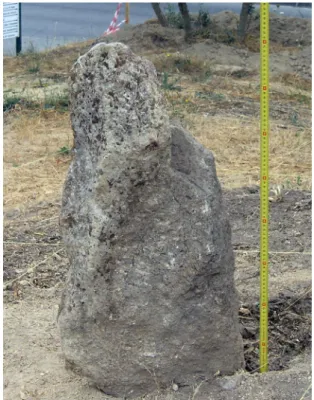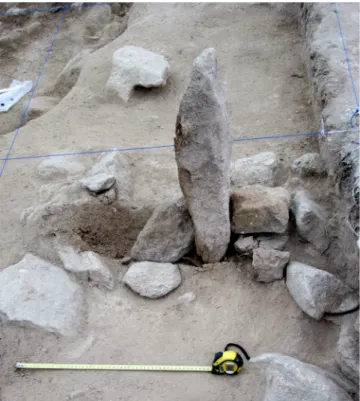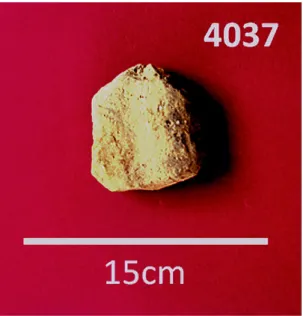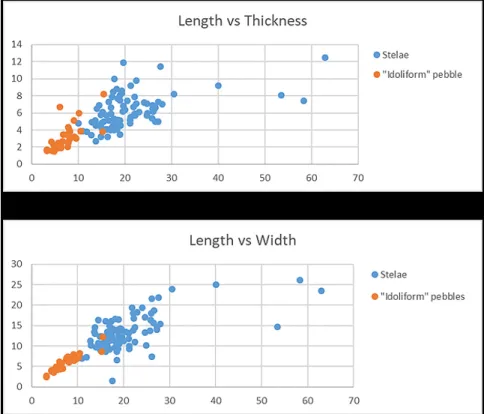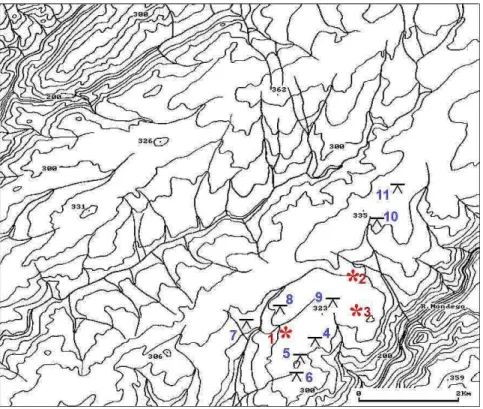| 183
IDEOTECHNICAL REPRESENTATIONS IN THE MEGALITHISMOF MONDEGO´S PLATFORM: THE CASE OF ORCA DA LAPA DO LOBO, NELAS
Representações Ideotécnicas no Megalitismo da Plataforma do Mondego: O caso da Orca da Lapa do Lobo, Nelas
João Carlos de Senna-Martinez, Centre for Archaeology (Uniarq), University of Lisbon. 1600-214 Lisbon. Portugal
smartinez@fl.ul.pt
Margarida M. Carvalho, MA in Archaeology, Centre for Archaeology (Uniarq), University of Lisbon. 1600-214 Lisbon. Portugal
maggie.carvalho@sapo.pt
ABSTRACT
The four excavation campaigns (2015-2018) carried out in the “ Orca da Lapa do Lobo” (County of Nelas, District of Viseu) revealed a situation, unique in the regional context in which it operates, of a tumular structure functioning, in fact, as an “ancestors sanctuary”.
The symbolic practices associated with the various regional groups of Ibe-rian Peninsula Megalithism have been receiving increasing attention, in particular in what regards the ideotechnical representations associated with it, both structurally and within the scope of the mobile elements that make up the respective list of offerings.
In the second case we have the elements identified as “stelae” or “idols”, usually of anthropomorphic interpretation. From the site un-der study, the set of one hundred, thirty four mobile ideotechnical representations and a “fixed” one, the study of which is presented here – 98 stelae, 4 stele-monoliths, 31 “idol-like pebbles” and one ceramic representation in the first group and a stela-menhir in the se- cond - constitutes the largest group of ideotechnique artefacts so far re-covered in Iberia from a single megalithic monument.
We also discuss the possible significance of these items within the frame-work of the symbolic practices known and associated with the Neolithic of the Mondego Platform.
KEY WORDS: Megalithism, Mondego Platform, Ideotechnical Represen-tations
184 |
RESUMO
As quatro campanhas de escavações (2015-2018) efectuadas na “Orca da Lapa do Lobo” (Concelho de Nelas, Distrito de Viseu) revela- ram uma situação, única no âmbito regional em que se insere, de uma estrutura tumular funcionando, de facto, como um “santuário de ante- passados”.
As práticas simbólicas associadas aos diversos grupos regionais do megalitismo da Península Ibérica têm vindo a merecer crescen-te acrescen-tenção, em particular no que toca às representações de cariz ideotécnico a ele associadas, quer estruturalmente, quer no âmbito dos elementos móveis que integram o respectivo espólio associado.
No segundo caso se inserem elementos identificados como “estelas” ou “ídolos”, normalmente de interpretação antropomórfica. No caso em estudo, o conjunto de cento e trinta e quatro representações ideo- técnicas móveis e uma “fixa” cujo estudo aqui se apresenta – 98 es-telas, 4 estelas-monólitos, 31 “seixos idoliformes” e uma figuração cerâmica no primeiro grupo e uma estela-menhir no segundo – cons- titui, no âmbito peninsular, o maior conjunto de artefactos ideotécni-cos, provenientes de um único monumento megalítico, até agora conhecido.
Discute-se ainda a respectiva integração no âmbito das práticas simbóli-cas conhecidas e associadas ao Neolítico da Plataforma do Mondego. PALAVRAS-CHAVE: Megalitismo, Plataforma do Mondego, Represen-tações Ideotécnicas
The symbolic practices associated with the various regional groups of Iberian Peninsula Megalithism have been receiving increasing attention, in particu-lar in what regards the ideotechnical representations associated with it, both structurally and within the scope of the mobile elements that make up the respective list of offerings (Bueno Ramírez, Balbín Behrmann, and Barroso Bermejo, 2016).
In the second case we have the elements identified as “stelae” or “idols”, usually of an-thropomorphic interpretation. From the site under study, the set of one hundred, thirty four mobile ideotechnical representations and a “fixed” one, a first attempt to the study of which is presented here – 98 stelae, 4 stele-monoliths, 31 “idoliform pebbles” and one ceramic represen-tation in the first group and a stela-menhir in the second – constitutes the largest group of ideotechnique artefacts so far recovered in Iberia from a single megalithic monument.
| 185
1. ORCA DA LAPA DO LOBO GEOGRAPHICAL SETTING, SITE DISCO- VERY AND EXCAVATION BACK-GROUNDThe region surrounding the archaeological site is covered by the geological sheet no. 17C (Santa Comba Dão) of the Portuguese Geological Map at the scale 1:50 000 edited by Serviços Geológicos de Portugal in 1961. It cor-responds to a flat area that rises slightly to the west reaching altitudes over 400 meters in the region of Canas de Senhorim. This flat area between the Serras do Caramulo and Estrela is strongly incised by the deep and narrow valleys of the Mondego and Dão river basins, which, inland from their conflu-ence at Santa Comba Dão, are closely parallel to each other with a NE-SW orientation.
Considering the paleogeographic divisions of the Iberia Peninsula, the area of study belongs to the Central Iberian Zone, which is, according to Azevedo and Aguado (2013, p. 377) the segment of the European variscan orogeny where granitic rocks outcrop ex-tensively and with great typological variability. In the surroundings of the archaeological site, it is possible to find three diffe- rent varie-ties of two mica monzonite granite described in the geological map
Fig. 1 – Geological map of the region south of Viseu, with the location of the archaeo-logical site (adapted from the Geoarchaeo-logical Map of Portugal, scale 1:500000, 1992 ed., acquired by WMS from LNEG at http://www.igeo.pt/WMS/Geologia/CGP500K), (Oliveira, Pereira, Antunes, et al., 1992)
186 |
(Fig.1). The archaeological site is located on an outcrop of porfiroid grani- te, with very coarse grain to medium grain, however, nearby, there are also porfiroid granite with minerals of metamor-phism (cordierite, silimanite and andalusite), porfiroid granite with medium to fine grain, and, lastly, two mica granite with medium to fine grain (Teixeira, Brito de Carvalho, Barros, et al., 1961, p. 16–20).
Partially covering the granites, it is possible to find arkose-clay deposits, which include three different levels – (from top to bottom) quartz and quart-zite cobbles, thick arkosic-sandstone, and green compact colored clay (Tei- xeira, Brito de Carvalho, Barros, et al., 1961, p. 9–10). Since the geological map of Santa Comba Dão (1962) is much older than the map of the region of Viseu (sheet no.17-A of 2009 ), which is more detailed and uses different nomenclature, it was deemed important to co-relate the granitic rocks des- cribed in both maps.
The granites found in the region of Viseu are mainly divided according to the third variscan deformation phase (D3) and the ones described to the SE of the Viseu geologi-cal map and, therefore, closest to the area of study, are late/post-tectonic granites. These are not as deformed as the
Fig. 2 – Google aerial photo (2015) of the Orca da Lapa do Lobo and surroundings: (1) Av. 9 de Julho, 109; (2) The frontier marker between Nelas and Carregal do Sal counties
1 1303, Agosto, 3, Viseu – Sentença sobre a devação do couto de Canas dada por juízes de Viseu, em que anulam e revogam
a sentença dada por Lourenço Pirez de Oliveira do Conde, contra os herdamentos do Cabido no couto de Canas de Senhorim. Arquivo Distrital de Viseu, Pergaminhos, m.29, doc.24, 170x410 mm., gótica semi-curs.
| 187
sin-tectonic variety and include calcic plagioclase, two mica (mostly biotite) and have a porfiroid texture (Godinho, Neves, Pereira, et al., 2010, p. 15), which, in general, matches the granites described in the geological map of Santa Comba Dão.The Orca da Lapa do Lobo (ORLL – CNS34620) is located in the homony-mous village in Central Portugal, on a slightly elevated terrain, occupied by olive trees, bordering the 9th July Avenue, part of the EN234 that connects the Counties of Nelas and Carregal do Sal (Latitude 40.470802; Longitude -7.922419 - Sheet 211 of CMP 1/25000, 1992 edi-tion – Fig.2).
The monument has a long story, beginning with a mention in a medieval document (1303), when it is referred to as defining one of the limits of the then “Canas de Senhorim” county1..
All trace of the site location was then lost during the XIXth and XXth centu-ries. Succes-sively sought for by Leite de Vasconcelos (Vasconcelos, 1905: p.313), Irisalva Moita (Moita, 1966) and one of us (Senna-Martinez, 1989: p.70), only in 2013 it was redis-covered by Horácio Peixoto (Senna-Marti-nez, this volume).
Fig. 3 – Orca da Lapa do Lobo. The stela-menhir ORLL-1460 after it was redressed
2 Our field work was supported by Nelas County, Lapa do Lobo Foundation, The Fireman Humanitarian Association of Canas de
188 |
In 2014, our colleague Gertrudes Branco (DGPC-DRC), after a vegetation clean-up, was then able to confirm that it was a seemingly ruined tumulus corresponding to the lost monument.
At the Nelas County invitation we began the first of our four excavation sea-sons in the monument (20015-2018)2 in July 2015.
2. GRANITE STELA-MENHIR, STELAE AND STELAE-MONOLITHS, AND “IDOL-LIKE” QUARTZ PEBBLES: STRATIGRAPHIC CONTEXT, TYPOLOGY AND CLASSIFICATION
We have discussed elsewhere the complex stratigraphic situation presen- ted by the site of Orca da Lapa do Lobo (Senna-Martinez, this volume), so
Fig. 4 – Orca da Lapa do Lobo, “idol-like” quartz pebbles from the tumulus carapace: 881, 1233 and 3598, pentagonal type; 1087, 1120 and 1337 anthropomorphic type
3 The artefacts from this site are identified by the site’s acronym ORLL, followed by a serial number (so the stele-menhir is
| 189
we’ll only discuss here briefly those aspects pertaining to the discovery of the ideotechnic elements. The first to be found was the stele-menhir 14603 . This granite upright was found laying in the tumulus surface and its laying place could be significant, perhaps marking the front of the monument. The stele-menhir was made of a stone slab 80cm long by 68cm wide and with a medium thickness of 14cm, it has the shoulders cut to enhance the head and, in the front, two crude arms can be found in relief (Fig.3) giving it an unmistakable human shape.After discovering the stela-menhir we became aware that something diffe- rent from a regional standard Middle Neolithic dolmen was awaiting us. So we proceeded to re-move with extra care what was left of the monument carapace. We found it to be made mostly of unprocessed quartz pebbles, six of which had shapes that reminded us of the Stelae previously found in several megalithic monuments in Iberia– as in the dolmen of Lagunita III (Bue-no Ramírez, Barroso Bermejo and Balbín Behrman n, 2012: fig.14) – we consi- der them to be idoliforme pebbles specially chosen by their anthropomorphic shape like in other known cases (Fig.4).
The remaining elements come from a completely different stratigraphic layout that left no doubt of its deliberate nature. We’ll summarize here our interpretation of the site stratigraphic layout:
1- In a first moment an Early Neolithic habitat occupied the site, in a situation similar to what we found at Orca do Folhadal, Orca 2 do Ameal, and Orca 2 de Oliveira do Conde (Ventura, this volume). 2- Then, somewhere in the Middle Neolithic, a megalithic monument was built over it with probably a small polygonal orthostatic chamber. 3- In a third moment, what initially would have been a burial monu-ment was transformed into an “ancestor’s sanctuary”. The chamber was dismantled and the four orthostats were rearranged, one packed against the other, in where the head-stone of the chamber would have been. The deliberate nature of this situation is substantiated by the fact that the tumulus was raised three times with successive earth levels accumulation, each corresponding to the structuring of a pit in the middle of the monument, with “stone nests” built to support granite stelae and/or “idol-like” quartz pebbles. In the middle phase of tumulus rising, the central pit was complemented with two smaller ones with equal function and, in the upper phase with one more with identical function (Senna-Martinez, this volume).
Table-I summarizes the stratigraphic distribution of the ideotechnique items found.
190 |
Fig. 5 – Orca da Lapa do Lobo: A- granite Stelae (542,1751, 664, 3758, 3760, 4433) and “Idol-like” quartz pebbles (4576, 4939) of Type-1 (Pentagonal); B- granite Stelae (662, 549, 353,689, 1125, 2016, 570) and “Idol-like” quartz pebbles (2939, 282, 989, 576) of Type-2 (Anthropomorphic); C- granite Stelae (4153, 4092, 3768, 1988, 2199, 2016) and “Idol-like” quartz pebbles (2108, 4564, 2353, 3091) of Type-3 (Lozengic); D- granite Stelae (1088, 671, 663, 4135, 3660, 2560, 570, 3616) and “Idol-like” quartz pebbles (4294, 2552, 2632) of Type-4 (Necked); E- granite Stelae (3955, 3033, 4329, 1713, 4130,3793, 4291, 927) of Type-5 (Sub-parallelepiped); F- Stelae-monoliths (4329, 3627, 4387).
| 191
The recent attempt by Diáz Guardamino (2010) to systematize the ideo-graphic stele-like elements present in the Iberian Prehistory of Peasant Societies addressed mainly the larger ones, stelae-menhir and other upright stones, and left much of the mobile ones out. So next we will address the question of typology.After considering shape and relative dimensions of the items under study we propose the following types to classify them:
Type 1 – Pentagonal – Its one of the most obvious ones and, with some variation, it can be considered as expressing a clear enough anthropo-morphic resemblance (Fig.5-A), as registered by Bueno Ramírez, Balbín Behrmann, and Barroso Bermejo (2016: fig.5B).
Type 2 – Anthropomorphic – As the first exemplar to be found (353) they have shapes hinting to a human one with variations (Fig.5-B).
192 |
Type 3 – Lozengeful – With the approximate shape of a lozenge, but closely anthropo-morphic (Fig.5-C).
Type 4 – Necked – With a well marked neck (Fig.5-D).
Type 5 – Sub-parallelepiped – With a sub-rectangular shape in front view (Fig.5-E).
Type 6 – Irregular – All other shapes vaguely anthropomorphic.
Stelae-monoliths – Another category of ideotechnic items, less mobile then Stelae and “idol-like” pebbles, is the Stelae-monoliths. They are cha- racteristically very elongated, their width/length ratio being always inferior to 38 (Fig.5-F). We found four of them: one in the upper shrine phase, two in the middle shrine phase and one in the buttress. The one in the upper phase and another of the middle phase were found in their original positions (Fig.6). Pottery idol or idols? – One of the only two non-lithic items in our collection is ORLL-4037, an idol-like pentagonal figure (Type-1) made of pottery (Fig.7). Its fabric is very coarse, crudely finished and at first sight we took it to be another idol-like pebble. This finding makes us sure the shape is no coincidence. It be-longs to the upper phase of the “ancestor’s sanctuary” building.
The other non-lithic item that can be addressed as a possible ideotechnique artefact is an octagonal short prism in pottery (ORLL-4617 – Fig.8) that was found at the bottom of the lower shrine phase, and for which we don’t have any direct parallel. The closest artefacts we find regionally with any simila-
rities are much later and slightly different. We are thinking of the Buraco da Moura de S. Romão Early Bronze Age small pottery reel (Senna-Martinez, 1993). Nevertheless we could be in presence of an early prototype.
We compare in Table-II the stelae and idol-like pebbles according to type re- presenta-tiveness.
| 193
ideotechnique artefacts. While for stelae, types 1, 4 and 5 (anthropomor-phic, necked and sub-parallelepiped) account for about one fourth of the whole sample each, for the pebbles, types 1 with 45% and 2 with 39% together represent more than 80%. If in the stelae case we can suppose other anthropic reasons behind form-choosing, in the pebbles case the choosing would be regulated by geological constraints determining what natural forms would be available.In what regards the geological nature of the stelae and “idol-like” pebbles found at Orca da Lapa do Lobo there are two main groups – quartz pebbles and granite.
The 31 “idoliform” pebbles are made out of quartz and are generally white with an av-erage size of 7.38 cm of length, 5.85 cm of width and 3.19 cm of thick-ness. These rocks were most likely recovered from the previously mentioned Coja, Nave de Haver and Longroiva Arkose formation that outcrop at about 1km NW of the site.
Fig. 6 – Orca da Lapa do Lobo. Stele-monolith 4387, viewed from SE-NW, after it was redressed
194 |
Fig. 7 – Orca da Lapa do Lobo. Pottery idol-like pentagonal figure (Type-1)
Fig. 8 – Orca da Lapa do Lobo. Octagonal pottery prism (4617) from the lower phase of the shrine
| 195
Regarding the stelae, these are made out of granite and consist of two main groups in terms of texture, 75% are phaneritic equi- or inequigranular, while 25% are porfiroid with feldspar minerals generally over 1cm of length. In terms of mineralogy, these rocks are mostly composed of quartz, feldspar, phyllosili-cate minerals and mafic minerals (amphibole and/or pyroxene); the difference usually concerns the presence of either more muscovite or more biotite. This type of granite, including differences in texture, occurs in the location of the ar-chaeological site or near it, as was previously mentioned in the geological set-ting. In terms of measurements, these stelae have an average length of 20.74 cm, width of 13.24 cm and thickness of 6.06 cm. For both the “idoliform” peb-bles and the stelae, the width and thickness rise proportionally to the length and more dramatically so for the four stele-monoliths (Fig.9).Fig. 9 – Orca da Lapa do Lobo. Graphic representation of Length vs. Thickness and Length vs. Width for the 101 Stelae and Stele-monoliths (the 4 outliers) and 31 “Idol-Like” pebbles recovered
196 |
3. CONCLUDING… “ANCESTORS SHRINE?” AND REGIONAL CULTURAL SETTING
The emergence of early peasant societies brings in what we can consider an increased awareness of the natural seasonal cycle for plants and animals and its parallels with the agricultural cycle. One of the consequences of this state of affairs will be that these cy-cles become a metaphor for the symbolic explanation and regulation of life and death.
Another consequence will be that, almost everywhere, the earliest peasant societies will develop more or less schematic ideotechnique representations of women which consti-tute, according Gimbutas, a part of a “matrifocal and probably matrilineal, agricultural and sedentary, egalitarian and peaceful” society (Gimbutas, 1996, p.9).
The transition to a peasant’s way of life occurred at a different pace and in multiple forms, in the different regions of Iberia, combined or not with hunter-gatherer practices. This way, it’s by no means a sure thing that ag-riculture was everywhere in Iberia a pre-condition to the emergence of the construction of megalithic funerary monuments.
In several areas it can be argued that animal husbandry predominates (namely of ovi-caprids) together with different degrees of what we can call horticulture, hunting and gathering. Such is the case we have been arguing for Beira-Alta (Senna-Martinez, 1989; Senna-Martinez and Ventura, 2008b; Ventura, this volume). In our case study we have been stressing the impor-tance of acorn gathering. Specialized gathering, such as acorns as in Central Portugal, have in common with the different regional scales of agriculture and animal husbandry the adoption of a proprietarily attitude toward land (Fairbairn, 2000), leading to what we have called the passage from “use- -territories” to “occupation territories” (Senna-Martinez and Ventura, 1999a, 2008a), which we think to be behind the beginnings of the megalithism (Senna-Martinez and Ventura, 2008b).
The Neolithic saw a change both of territorial behavior and territorial aware-ness that we think would be legitimatized by the implantation of the mega-lithic necropolis. Thus, local ancestors’ presence account for an increasing territorial appropriation of space.
The surge in complexity brought about in the Late Neolithic megalithic mo- numents, both in their architecture and the funerary offerings found with-in (Senna-Martwith-inez and Ventura, 2000, 2008a), represents a positive rewith-in- rein-forcement of the legitimizing relation-ship between the livings with the dead. The perception of the ancestors/dead as “protec-tive entities” seems thus to be reinforced in the Late Neolithic to take into account the increased effort
| 197
in the construction of the great monuments.The Late Neolithic dolmens would welcome (as in other regional areas) an in-creased number of bodies, materialized in the clear increase of the artefac-tual assemblages de-posited within them, while their complex intra-tumular corridors and atriums would accommodate a growing number of participants in the rituals taking place (Senna-Martinez and Ventura, 1999b).
We think that the case of the Orca da Lapa do Lobo “ancestors shrine” can thus be seen in the light of these transformations. So the story of the site could probably be told like this:
Fig. 10 – Habitat sites and megalithic monuments of the Orca da Lapa do Lobo surroundings: (1) Early Neolithic habitat sites near or under Middle Neolithic dolmens: 6 - Orca 2 do Ameal, 8 - Orca 2 de Oliveira do Conde; 11 – Orca da Lapa do Lobo; (2) Other Middle Neolithic dolmens: 5 - Orca 1 do Ameal; (3) Late Neolithic habitat sites, large dolmens and the stelae “ancestors shrine” of Orca da Lapa do Lobo: 1- Habitat do Ameal-VI; 2 - Habitat do Mimosal; 3 - Habitat do Campo de Tiro; 4 - Orca dos Fiais da Telha; 7 - Orca 1 de Oliveira do Conde; 9 - Orca do Santo, 10 - Orca do Outeiro do Rato; 11 – Orca da Lapa do Lobo.
4 Fall acorn and other winter fruits gathering and processing seems to go together, in several Iberian re-gional areas, namely in
Beira--Alta, with the period (fall and winter) when building of megalithic tombs took place, either we agree with the solar hypothesis for their orientations (Hoskin, et al. 1998; Hoskin, 2001) or take into consideration other proposed astronomical orientations (Silva, 2012)
198 |
1- Somewhere during the Early Neolithic the highest place in the area would see the establishment of a small village, already living through a seasonal cycle, wintering in the lowlands and using spring/summer highland pastures in Serra da Estrela4.
2- With the reinforcement of a more territorial attitude, in the Middle Neo-lithic, the building of a small dolmen begun the process of legitimizing the nearby settlement of people. Would it be the tomb of the local first lineage ancestors?
3- The more complex situation developing with the beginning of the Late Neolithic led to the establishing of a necropolis of several large dolmens with several habitat sites in between them (Fig.10). The site of Orca da Lapa do Lobo would then be transformed into a kind of an “ancestors’ shrine”, like an axis mundi organizing the symbolic life of the surrounding communities. 4- The site being abandoned at the end of the Neolithic, somewhere in the Middle Age the local place name was changed to “Cruz Alta” reclaiming to the Christian orbit an ancient “memory place”.
Canas de Senhorim, Bruxelas, Lisboa, August, 2018 REFERENCES:
AZEVEDO, M. and AGUADO, B. (2013) – Origem e instalação de Granitóides Varis-cos na Zona Centro-Ibérica. Geologia de Portugal. Lisboa: Escolar Editora, Vol. I – Geologia Pré-Mesozóica de Portugal, p.377–401.
BUENO RAMÍREZ, P; BALBÍN BEHRMANN, R. and BARROSO BERMEJO, R. (2016) – Megalithic art in the Iberian Peninsula Thinking about graphic discourses in the Europe-an Megaliths. Guillaume Robin, André D’Anna, Aurore Schmitt Europe-and Maxence Bailly, Eds. Fonctions, utilisations et représentations de l’espace dans les sépultures monumentales du Néolithique européen. Aix-en-Provence. Presses Universitaires de Provence. p.185-203.
DÍAZ-GUARDAMINO, M. (2010) – Las estelas decoradas en la Prehistoria de la Penínsu¬-la Ibérica. Madrid. Universidad Complutense de Madrid. PhD Thesis.
FAIRBAIRN, A.S. (2000) – On the spread of crops across Neolithic Britain, with spe-cial reference to the southern England. A.S. FAIRBAIRN, ed. Plants in Neolithic Brit-ain and beyond. Oxford. Oxbow Books, p.107-121.
GIMBUTAS, M. (1996) – The Goddesses and Gods of Old Europe. London. Thames and Hudson.
GODINHO, M. M.; NEVES, L.; PEREIRA, A.; SEQUEIRA, A.; CASTRO, P. and BENTO DOS SANTOS, T. (2010) – Notícia Explicativa da Folha 17-A (Viseu). (N. Ferreira, Ed.) Lisboa: Unidade de Geologia e Cartografia Geológica (Laboratório Nacional de Energia e Geolo-gia).
| 199
megalithic Tombs of Northern and Western Iberia. Archaeoastronomy. 23 (JHA, xxix), p. S59-S62.
HOSKIN, M. (2001) – Tombs, Temples and their Orientations. Bognor Regis. Ocarina Books.
MOITA, I. (1966) – Características predominantes do grupo dolménico da Beira Alta. Eth-nos. V, p.189-297.
OLIVEIRA, J. T.; PEREIRA, E.; ANTUNES, M. T. and MONTEIRO, J. H. (1992) – Carta Geológi-ca de Portugal. EsGeológi-cala 1:500000. Serviços Geológicos de Portugal.
SENNA-MARTINEZ, J.C. (1989) – Pré-História Recente da Bacia do Médio e Alto Monde-go: algumas contribuições para um mode¬lo sociocultural. Lisboa. Faculdade de Letras da Universidade de Lisboa. Tese de Doutoramento em Pré-História e Arqueolo-gia. 3 Vols. SENNA-MARTINEZ, J.C. (1993) – A ocupação do Bronze Pleno da ‘Sala 20’ do Bura-co da Moura de São Romão. Tra¬ba¬lhos de Arqueologia da EAM. 1, p.55-76.
SENNA-MARTINEZ, J.C. (this volume) – A Shrine in the Neolithic? Orca da Lapa do Lobo, Nelas (c. 5000-3000 BC). J. C. Senna-Martinez, Mariana Diniz e A. Faustino de Carval-ho, Eds. De Gibraltar aos Pirenéus: Megalitismo, Vida e Morte no Ocidente Peninsular. Fundação Lapa do Lobo.
SENNA-MARTINEZ, J.C. & VENTURA, J.M.Q. (1999a) – Evolução das Paisagens Culturais na Plataforma do Mondego na Pré-História Recente (c.5000-550 cal AC). Trabalhos de Arqueologia da EAM. Lisbon. Colibri. 5, p. 9-20.
SENNA-MARTINEZ, J. C. & VENTURA, J. M. (1999b) – Espaço Funerário e «Espa-ço Céni-co»: a Orca do Folhadal (Nelas). Trabalhos de Arqueologia da EAM. Lisboa. 5, p.21-34. SENNA-MARTINEZ, J.C. and VENTURA, J.M.Q. (2000) – Pastores, recolectores e constru-tores de megálitos: O Neolítico Final. J. C. SENNA-MARTINEZ e I. PEDRO, Eds. Por Terras de Viriato: Arqueologia da Região de Viseu. Viseu: Governo Civil do Distrito de Viseu e Museu Nacional de Arqueologia, p. 53-62.
SENNA-MARTINEZ, J.C. e VENTURA, J.M.Q. (2008a) – Do mundo das sombras ao mun-do mun-dos vivos: Octávio da Veiga Ferreira e o megalitismo da Beira Alta, meio século de-pois. Homenagem a Octávio da Veiga Ferreira. Estudos Arqueológicos de Oeiras. Oeiras. Câmara Municipal. 16, p.317-350.
SENNA-MARTINEZ, J.C. e VENTURA, J.M.Q. (2008b) – Neolitização e Megalitismo na Plataforma do Mondego: Algumas Reflexões sobre a Transição Neolítico Anti-go/Neolíti-co Médio. Actas del IV Congreso del NeolítiAnti-go/Neolíti-co en la Península Ibérica. Ali-cante. 2, p. 77-84.
SILVA, F. (2012) – Landscape and Astronomy in Megalithic Portugal: the Carregal do Sal Nucleus and Star Mountain Range. Papers from the Institute of Archaeology (PIA). 22, p.99-114. DOI: http://dx.doi.org/10.5334/pia.405
TEIXEIRA, C.; BRITO DE CARVALHO, L. H.; BARROS, R. F.; ÁVILA MARTINS, J. and HAAS, W. E. L. (1961) – Notícia Explicativa da Folha 17-C (Santa Comba Dão). Lisboa. Serviços Geológicos de Portugal.
VASCONCELOS, J.L. (1905) – Antiguidades prehistoricas da Beira. IV- Notícia de duas Orcas. O Archeólogo Português. 10, p.313.
WILLIAMS, M. (2003) – Growing metaphors: The agricultural cycle as metaphor in the later prehistoric period of Britain and North-Western Europe. Journal of Social Archaeol-ogy. 3, p.223-255.
